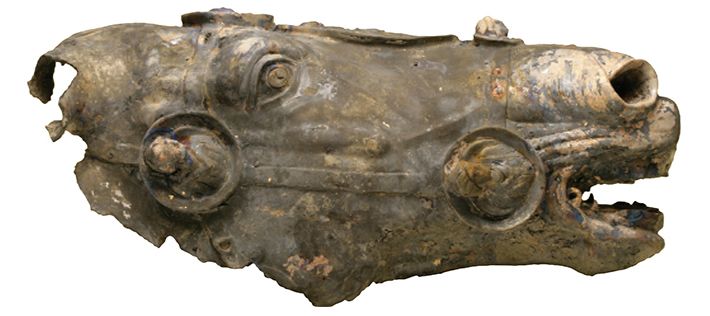A 2,000-Year-Old Golden Horse Head Suggests Romans Actually Got Along Wth German ‘Barbarians’
The sculpture fragment suggests Romans lived peacefully alongside Germans until a decisive defeat at the Battle of Teutoburg Forest
/https://tf-cmsv2-smithsonianmag-media.s3.amazonaws.com/filer/68/1e/681ed7d9-ee9a-402d-9add-fc7be8ed6fe2/pferdekopf_2.jpg)
Some 2,000 years ago, a monumental bronze sculpture of the Roman emperor Augustus and his trusted steed welcomed visitors to the central marketplace of Waldgirmes, an ancient settlement near modern-day Frankfurt, Germany. Made of bronze covered in gold leaf and weighing an estimated 900 pounds, the equestrian statue was an imposing presence in the newly annexed province. It reminded viewers of imperial might with symbols like the Roman war god Mars affixed onto the horse’s bridle.
Today, a gilded horse head and miscellaneous small fragments are all that remain of the sculpture. But as Andrew Curry reports for National Geographic, the 55-pound head retains much of its majestic power. Now on view just north of Frankfurt at the Saalburg Roman Fort, the sculpture introduces a twist in the established story of Roman-Germanic relations.
Prior to the launch of excavations at Waldgirmes in 1993, historians believed the Roman Empire limited its engagement with German affairs to the occasional military raid, Science Magazine notes. Lacking evidence of early Roman settlements across Germany, researchers identified the Battle of Teutoburg Forest as the turning point in Rome’s empire-building trek across Europe. They speculated that the embarrassing defeat delineated the borders of the Roman frontier.
According to Karen Schousboe of Ancient History Encyclopedia, the battle took place late in the year 9 A.D. German warriors ambushed three legions of Roman soldiers led by general Publius Quinctilius Varus. Despite being vastly outnumbered, the Germans annihilated their enemies. The battered Romans retreated, setting up a northern perimeter along the Rhine River.
The artifacts found at Waldgirmes suggest that Teutoburg Forest is only part of the story. They indicate the Romans lived next to and traded with the Germans peacefully for years, National Geographic’s Curry writes. Researchers have yet to find a barracks or any evidence of a large military presence at Waldgirmes.

Wood buildings dated to around 4 B.C. reveal a surprisingly advanced town. It was filled with Roman-style residences, pottery and woodworking workshops, and classic Roman structures including a forum, or marketplace. Here, archaeologists identified five pedestals that once housed life-size equestrian sculptures—including the one of Augustus now represented solely by the horse’s head.
The head, which was discovered at the bottom of a 33-foot well in 2009, speaks to the previously underestimated presence of Roman settlements in Germany and the disastrous consequences of Teutoburg.
In a separate article for Archaeology, Curry writes that the sculpture fragment was wedged underneath eight millstones, as well as an array of everyday items such as wooden buckets, sticks and fence posts. Littered across the site were more than 160 bronze fragments, mainly consisting of minuscule splinters, indicating the Germans probably recycled bronze sculptures for their own use. As for the horse head, Siegmar von Schnurbein, an archaeologist and director of the German Archaeological Institute’s Romano-Germanic Commission, hypothesizes that it was thrown into the well as part of a ritualized water sacrifice commonly seen in Germanic areas.
Whatever the exact reasoning behind the sculpture’s ignominious end, Teutoburg precipitated the speedy decline of Waldgirmes and other German settlements. Within several years of the battle, the site was evacuated, likely voluntarily due to heightened Roman-Germanic tensions. The buildings of Waldgirmes were torched, perhaps to prevent Germanic tribes from taking over the settlement.
“In the final fire, everything was wiped out, ground down to the earth,” lead researcher Gabriele Rasbach tells Curry. “You can see burning along the entire wall.”
According to a press release, the head has been extensively restored to highlight its gilded exterior and decorative details. Entangled in legal battles for nearly a decade, it is finally being exhibited to the public, enabling viewers to envision its former glory and immerse themselves in the forgotten 2,000-year-old world.
/https://tf-cmsv2-smithsonianmag-media.s3.amazonaws.com/accounts/headshot/mellon.png)
/https://tf-cmsv2-smithsonianmag-media.s3.amazonaws.com/accounts/headshot/mellon.png)